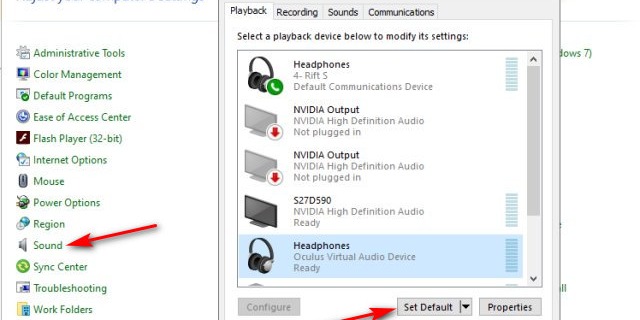

For example, the timestamp "DC 07 0C 00 03 00 05 00 0A 00 3A 00 15 00 43 03" can be interpreted as follows:ĭuring audio playback the function MMDevAPI!CLocalEndpointEnumerator::GetDefaultEndpoint() picks the device (endpoint) with the latest timestamp as the default playback device.

This timestamp is retrieved by calling GetSystemTime() and is written out to the registry as the SYSTEMTIME structure. HKLM\SOFTWARE\Microsoft\Windows\CurrentVersion\MMDevices\Audio\Render\.Įach "Role" value contains the timestamp of when the device was last configured as the default device. Select Reset under Reset sound devices and volumes for all apps to the. The RPC server side function AudioSRV!CPolic圜onfig::SetDefaultEndpoint() calls the function MMDevAPI!CEndPointManager::SetDefaultEndpoint() which writes a timestamp to the values named "Role:0", "Role:1" and "Role:2" in the following registry key: Settings Select System > Sound > Volume mixer. The Windows Audio Service is implemented in AudioSRV.dll which is hosted in the instance of SVCHost.exe running with the command line "svchost -k LocalServiceNetworkRestricted". Now open the Advanced tab from the top menu. Select Properties from the file to access more device options.

"C:\Windows\system32\rundll32.exe shell32.dll,Control_RunDLL mmsys.cpl,playback"Īfter this when the user selects a playback device in the "Playback" property sheet and clicks "Set Default", the control panel plug-in DLL (MMsys.cpl) calls the function AUDIOSES!CPolic圜onfigClient::SetDefaultEndpoint() to send an RPC/ALPC request to the Windows Audio Service to set the default device as selected by the user. Once in the audio settings, go to the Playback tab and navigate to your speaker/headphone icon. If Audio isn't there, click on Widget Menu.Ĭlick on the arrow to expand all devices.When a user right-clicks on the speaker icon in the Windows taskbar and selects say "Playback devices", the sound control panel starts up which comprises of entails running mmsys.cpl running under rundll32.exe with the following command line: How to Change The Default Sound Output Device in Windows 10 - Game BarĬlick on Audio. Right-click on the output device you want and click on Set as Default Device. How to Change The Default Sound Output Device in Windows 10 - Control Panel How to Change The Default Sound Output Device in Windows 10 - Settings That device will automatically play sound.Ĭlick anywhere on your screen to close the playback device settings if it's still on your screen. How to Change The Default Sound Output Device in Windows 10 - TaskbarĬlick on the speaker icon in the lower-right corner of your screen.Ĭlick on the small arrow to expand the list of devices.Ĭlick on the playback device you want to use. Here are the different ways to change the default sound device. Sometimes your sound might not be working, requiring you to select the right output device. Any device that can play sounds on your computer, including speakers and headphones, will be listed as an output device.


 0 kommentar(er)
0 kommentar(er)
